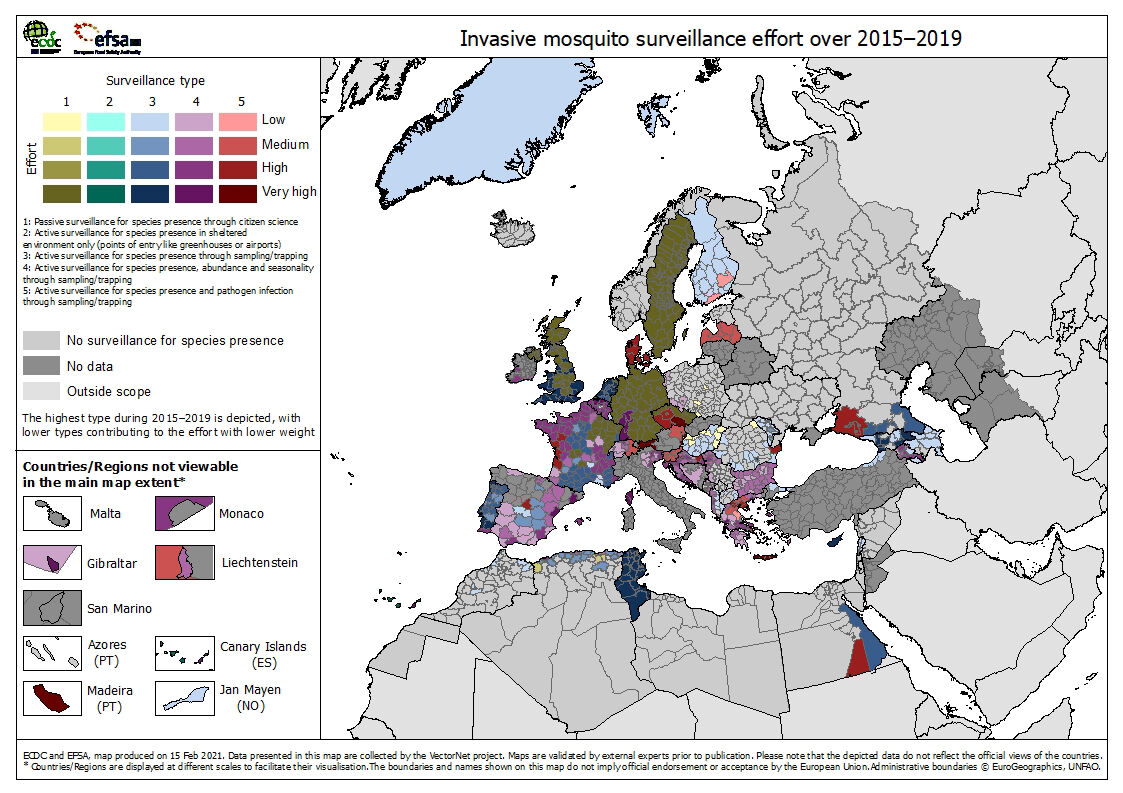Invasive mosquito surveillance effort over 2015–2019
The map 'Invasive mosquito surveillance effort over 2015–2019' shows the surveillance effort per administrative area, by highest surveillance type.

Download

The surveillance categories are:
1 = passive surveillance for species presence through citizen science
2 = active surveillance for species presence in sheltered environment only (points of entry like greenhouses or airport building)
3 = active surveillance for species presence through sampling/trapping (with or without passive surveillance)
4 = active surveillance for species presence, abundance and seasonality through sampling/trapping (with or without passive surveillance)
5 = active surveillance for species presence and pathogen infection through sampling/trapping (with or without passive surveillance)
The highest surveillance type that occurred in an administrative area during 2015–2019 is depicted, with lower type categories contributing to the effort score with a lower weight. Weights were as follows:
Table: Weights for invasive mosquito surveillance effort
|
|
Highest level |
||||
|
Level |
1 |
2 |
3 |
4 |
5 |
|
1 |
1 |
0 |
0 |
0 |
0 |
|
2 |
|
1 |
1 |
0.5 |
0.25 |
|
3 |
|
|
1 |
0.5 |
0.25 |
|
4 |
|
|
|
1 |
0.5 |
|
5 |
|
|
|
|
1 |
The data (occurrence of any surveillance activity type during the time period in the administrative unit) was collected by year over 2015 and 2016, and by month over 2017, 2018 and 2019 (The years 2015 and 2016 each carrying 1/12th of the weight of the later years). The score was summed and divided by the maximum score (38) and distributed over the four Effort classes (Low, Medium, High and Very high) according to equal intervals.
Surveillance for invasive mosquitoes is concentrated in Western Europe, the Balkans, the Caucasus and the western part of North Africa, and the reported surveillance effort is generally high. Compared to the pattern shown in the map of January 2019, the current data show more surveillance activity in much of Sweden, Finland and parts of North Africa, but is largely similar elsewhere. Invasive mosquito surveillance by citizen science is predominant in northern and central Europe whilst various forms of active surveillance tend to be most common in south-western Europe and the Balkans.
The main surveillance activities for invasive mosquitoes are targeting Ae. albopictus for its presence (introduction and spread), and less frequently for its abundance as part of disease control. Given the current known distributions (i.e. countries were invasive species are present or at high risk to be present, or where distribution data exist and are reported), there are obvious gaps in the reported surveillance data. There is also a need for strengthening the low intensity of surveillance efforts in countries where Ae. albopictus and other invasive species might be present but undetected in many administrative units. Finally, assessing seasonal surveillance patterns and analysing the mosquito population activity (i.e. abundance and seasonality) should be prioritised to help prevent/control possible disease outbreaks in areas were Ae. albopictus is well established and that are receptive to pathogen introduction.
Suggested citation: European Centre for Disease Prevention and Control and European Food Safety Authority. Mosquito maps [internet]. Stockholm: ECDC; 2021. Available from: https://ecdc.europa.eu/en/disease-vectors/surveillance-and-disease-data…




